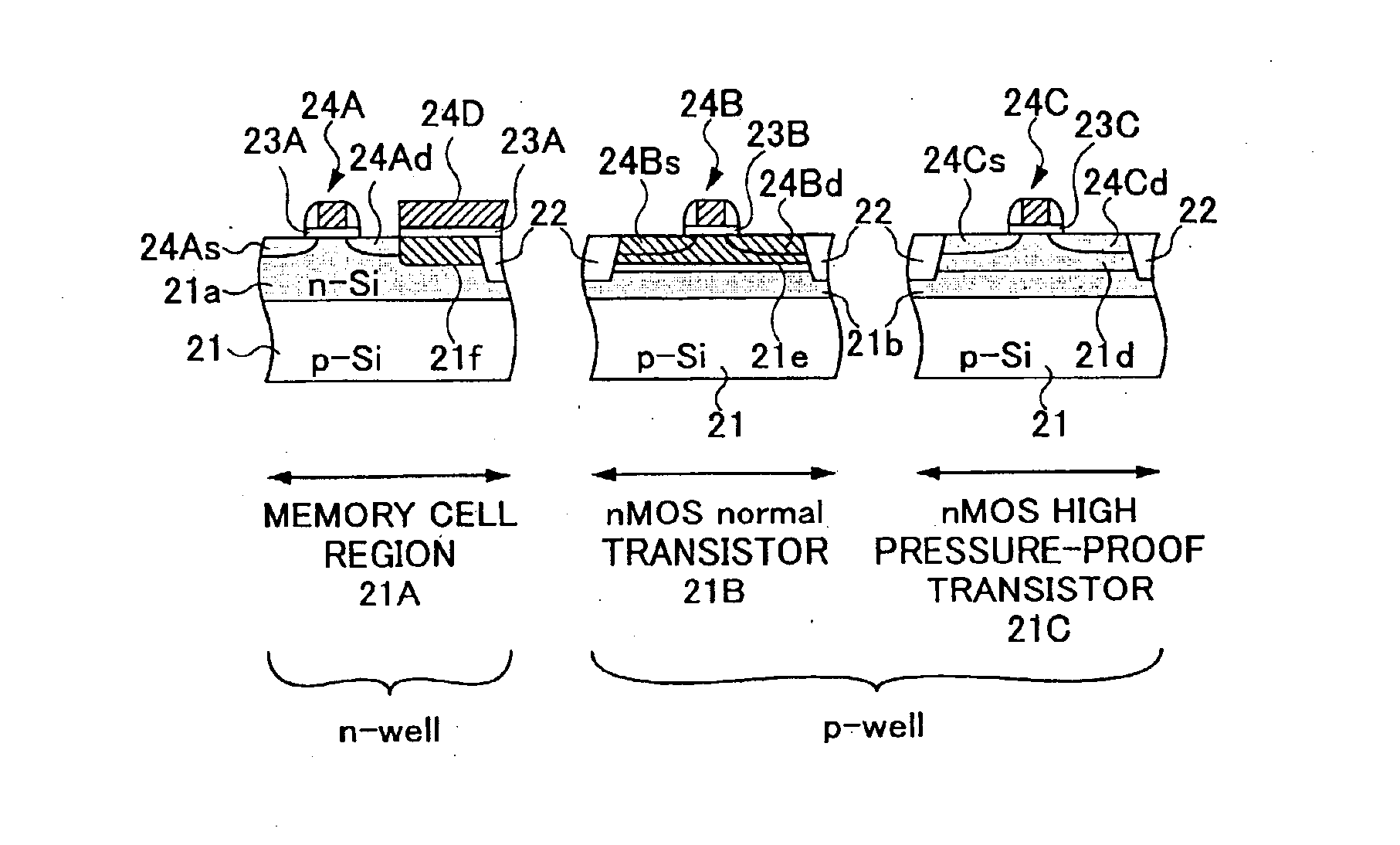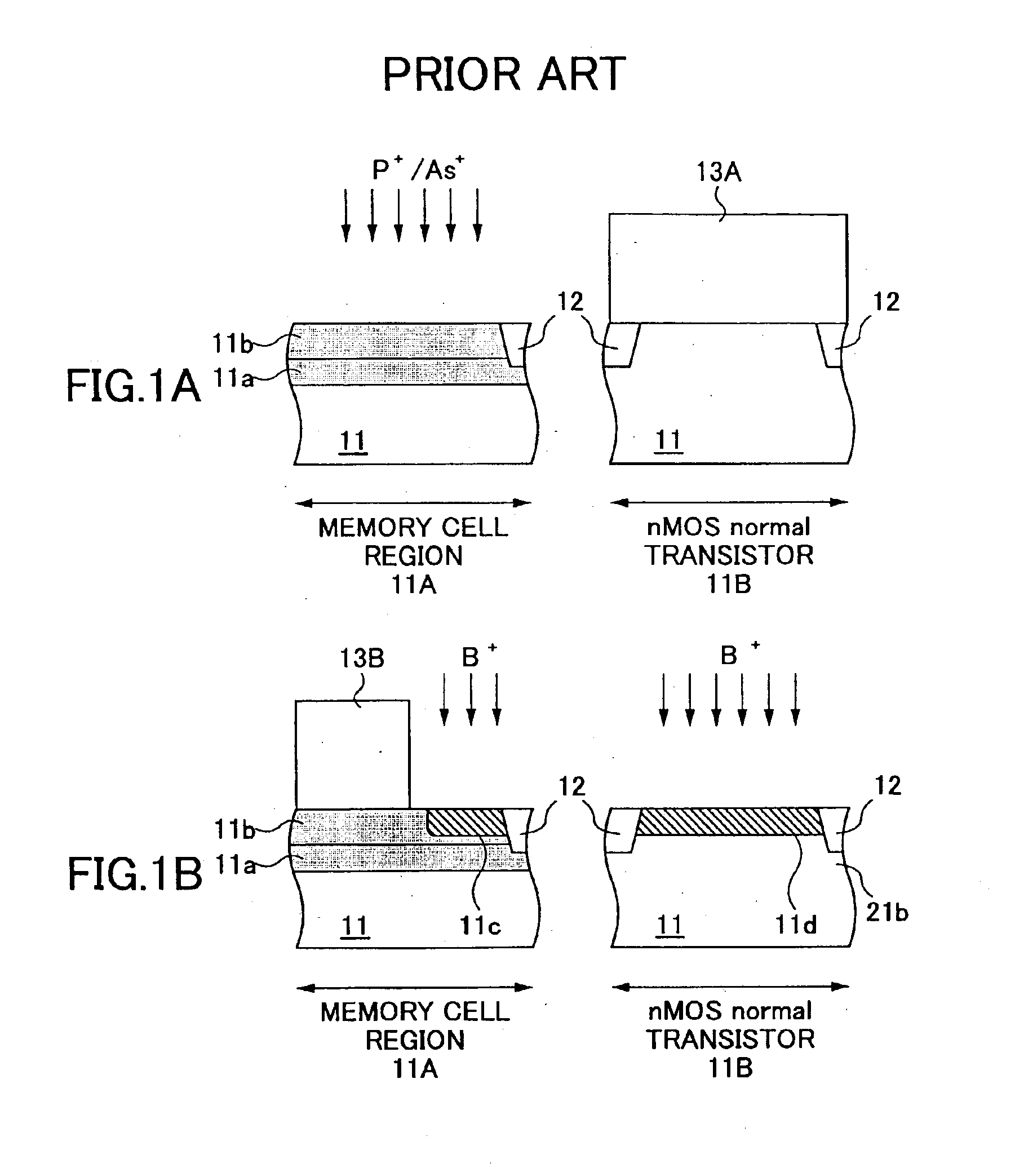Semiconductor integrated circuit apparatus and fabrication method thereof
- Summary
- Abstract
- Description
- Claims
- Application Information
AI Technical Summary
Benefits of technology
Problems solved by technology
Method used
Image
Examples
first embodiment
A description will now be given, with reference to FIGS. 2A through 2E, of a semiconductor integrated circuit apparatus according to the present invention.
FIGS. 2A through 2E show a fabrication process of the semiconductor integrated circuit apparatus according to the first embodiment.
Referring to FIGS. 2A through 2E, element regions 21A through 21C are defined on a p-type Si substrate 21 by an element separation structure 22 such as an STI structure. The element region 21A has an n-type well 21a.
In a process in FIG. 2A, a resist pattern R1 covers the element region 21A having the n-type well 21a. When ions of a p-type impurity element such as B are implanted into the element regions 21A through 21C, for instance, at an acceleration voltage of 300 keV with a dose of 3×1012 ions / cm2 by using the resist pattern R1 as a mask, it is possible to form p-type wells 21b in the element regions 21B and 21C. Subsequently, when the ions of the p-type impurity element are implanted at an accele...
second embodiment
A description will now be given, with reference to FIG. 4A through 4E, of a semiconductor integrated circuit apparatus fabrication process according to the present invention.
FIGS. 4A through 4E show a fabrication process of the semiconductor integrated circuit apparatus according to the second embodiment.
Referring to FIGS. 4A through 4E, element regions 31A through 31C are defined on a p-type Si substrate 31 by an element separation structure 32 such as an STI structure. In a process in FIG. 4A, P ions are uniformly implanted into the element regions 31A through 31C, for instance, at an acceleration voltage of 500 keV with a dose of 3×1012 ions / cm2. As a result, an n-type well 31a is formed in each of the element regions 31A through 31C. Subsequently, As ions are uniformly implanted into the element regions 31A through 31C, for instance, at an acceleration voltage of 150 keV with a dose of 5×1012 ions / cm2. As a result, it is possible to form n-type regions 31b having a predetermined...
third embodiment
A description will now be given, with reference to FIGS. 5A through 5G, of a fabrication process of a semiconductor integrated circuit apparatus according to the present invention.
FIGS. 5A through 5G show the fabrication process of the semiconductor integrated circuit apparatus according to the third embodiment.
Referring to FIGS. 5A through 5G, a memory cell region 41A, an element region 41B where an nMOS transistor, a part of a CMOS logic element, is to be formed, an element region 41C where a high pressure-proof nMOS transistor is to be formed, an element region 41D where a pMOS transistor, another part of the CMOS logic element, is to be formed, and an element region 41E where a high pressure-proof pMOS transistor is to be formed are defined on a p-type Si substrate 41 by an element separation structure 42 such as an STI structure.
In a process in FIG. 5A, a resist pattern R4 covers the element regions 41B and 41C. In order to form an n-type well 41a, P ions are implanted into the...
PUM
 Login to View More
Login to View More Abstract
Description
Claims
Application Information
 Login to View More
Login to View More - R&D
- Intellectual Property
- Life Sciences
- Materials
- Tech Scout
- Unparalleled Data Quality
- Higher Quality Content
- 60% Fewer Hallucinations
Browse by: Latest US Patents, China's latest patents, Technical Efficacy Thesaurus, Application Domain, Technology Topic, Popular Technical Reports.
© 2025 PatSnap. All rights reserved.Legal|Privacy policy|Modern Slavery Act Transparency Statement|Sitemap|About US| Contact US: help@patsnap.com



